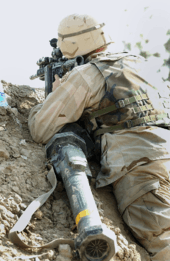Forward Operating Base Chapman

Forward Operating Base Chapman, also known as Camp Chapman, is a United States military base located at the site of a former Afghan Army installation that is also being used by the Central Intelligence Agency.
Forward Operating Base Chapman is situated in Khost province, Afghanistan, on an airstrip 2 miles east of Khost. It is near Camp Salerno, a large military base used by U.S. special operations forces.[1][2] The base is named for Sergeant First Class Nathan Chapman, the first U.S. soldier killed by enemy fire during the Afghanistan war, in 2002.[2][3][4][5] Chapman was killed while fighting alongside the CIA.[4]
History
The CIA's base in Khost was set up at the beginning of the U.S.-led offensive against al-Qaeda and the Taliban in 2001, and began as an improvised center for operations.[6] A military base at the beginning, it was later transformed into a CIA base, a U.S. official said.[7] According to a U.S. military source, Forward Operating Base Chapman was also used as a base for the Khost Provincial Reconstruction Team, a military-led development group.[8] According to an individual who was in the PRT and took part in the relocation; this team left in 2011 and moved to FOB Salerno.[9][10] In recent years, the base, one of the most secretive and highly guarded locations in Afghanistan, evolved into a major counterterrorism hub of the CIA's paramilitary Special Activities Division, used for joint operation with CIA, military special operations forces and Afghan allies, and had a housing compound for U.S. intelligence officers.[2][6][11][12]
On Wednesday, December 30, 2009, the Camp Chapman attack was executed by suicide bomber Humam Khalil al-Balawi who was a Jordanian double agent loyal to al-Qaeda-linked Islamist extremists. Seven people employed by or affiliated with the CIA, including the chief of the base, Jennifer Lynn Matthews[13] as well as a Jordanian intelligence officer, died in the attack. It remains the second-deadliest incident ever for the CIA after the 1983 United States embassy bombing. Almost three years later, on Wednesday, December 26, 2012, a suicide bomber, possibly with ties to the Afghan Taliban (who claimed responsibility via a spokesman, Zabihullah Mujahid, claiming those who served American forces at the base were the target) and/or the Haqqani network, killed three Afghans (their status was not specified) who were outside the perimeter of the base, which is near a military airport.[14]
U.S. bases in Khost, in particular Camp Salerno, have frequently been targeted by insurgents. In most cases, however, suicide attackers do not succeed in getting past the main entrance of a base.[15] According to U.S. officials, Forward Operating Base Chapman appears to have implemented less stringent security measures that other U.S. military bases, aiming at establishing trust with informants.[16] Subjecting informants to mistrust and excessive suspicion would reduce the amount of information received from them.[17]
References
- ↑ Oppel, Richard A.; Mazzetti, Mark; Mekhennet, Souad (January 4, 2010). "Behind Afghan Bombing, an Agent With Many Loyalties". New York Times. Retrieved January 5, 2010.
- 1 2 3 Warrick, Joby; Constable, Pamela (January 1, 2010). "CIA base attacked in Afghanistan supported airstrikes against al-Qaeda, Taliban". Washington Post. Retrieved January 1, 2010.
- ↑ Youssef, Nancy A. (December 31, 2009). "Taliban infiltrator who killed 7 from CIA wore Afghan uniform". McClatchy. Retrieved January 1, 2009.
- 1 2 Meek, James Gordon (January 1, 2010). "Suicide bombing at CIA camp in Afghanistan likely revenge attack by Taliban warlord - a former ally". New York Daily News. Retrieved January 1, 2010.
- ↑ Mazzetti, Mark (December 31, 2009). "C.I.A. Takes On Bigger and Riskier Role on Front Lines". New York Times. Retrieved January 1, 2010.
- 1 2 Gorman, Siobhan (January 1, 2010). "Suicide Bombing in Afghanistan Devastates Critical Hub for CIA Activities". Wall Street Journal. Retrieved January 1, 2010.
- ↑ Shah, Amir (December 31, 2009). "CIA Director: 7 CIA Workers Killed In Afghanistan". Associated Press. Retrieved January 1, 2010.
- ↑ Starkey, Jerome (January 1, 2001). "Afghan suicide bomber kills seven CIA agents after attacking base". The Times. Retrieved January 2, 2009.
- ↑ "Source: 2 killed in Afghanistan bombing were security contractors". CNN. December 31, 2009. Retrieved January 1, 2010.
- ↑ Gopal, Anand (January 2, 2010). "Taliban: CIA Attack Was Retaliation for Drone Strikes". Wall Street Journal. Retrieved January 2, 2010.
- ↑ Sengupta, Kim (January 1, 2010). "Suicide attack inflicts worst death toll on CIA in 25 years". The Independent. Retrieved January 1, 2010.
- ↑ Smith, Adèle (January 1, 2010). "La CIA perd sept espions sur une base secrète". Le Figaro. Retrieved January 2, 2010.
- ↑ Who was who in the hunt for bin Laden, The Week, April 30, 2013
- ↑ http://worldnews.nbcnews.com/_news/2012/12/26/16156522-blast-in-afghan-city-of-khost-taliban-says-us-base-targeted?lite=
- ↑ Rubin, Alissa J.; Mazzetti, Mark (December 31, 2009). "Afghan Base Hit by Attack Has Pivotal Role in Conflict". New York Times. Retrieved January 1, 2010.
- ↑ Gorman, Siobhan; Dreazen, Yochi J. (January 2, 2010). "Killings Rock Afghan Strategy". Wall Street Journal. Retrieved January 2, 2010.
- ↑ Rajghatta, Chidanand (January 3, 2010). "Pak tribesman killed 7 CIA agents and trust". Times of India. Retrieved January 3, 2010.